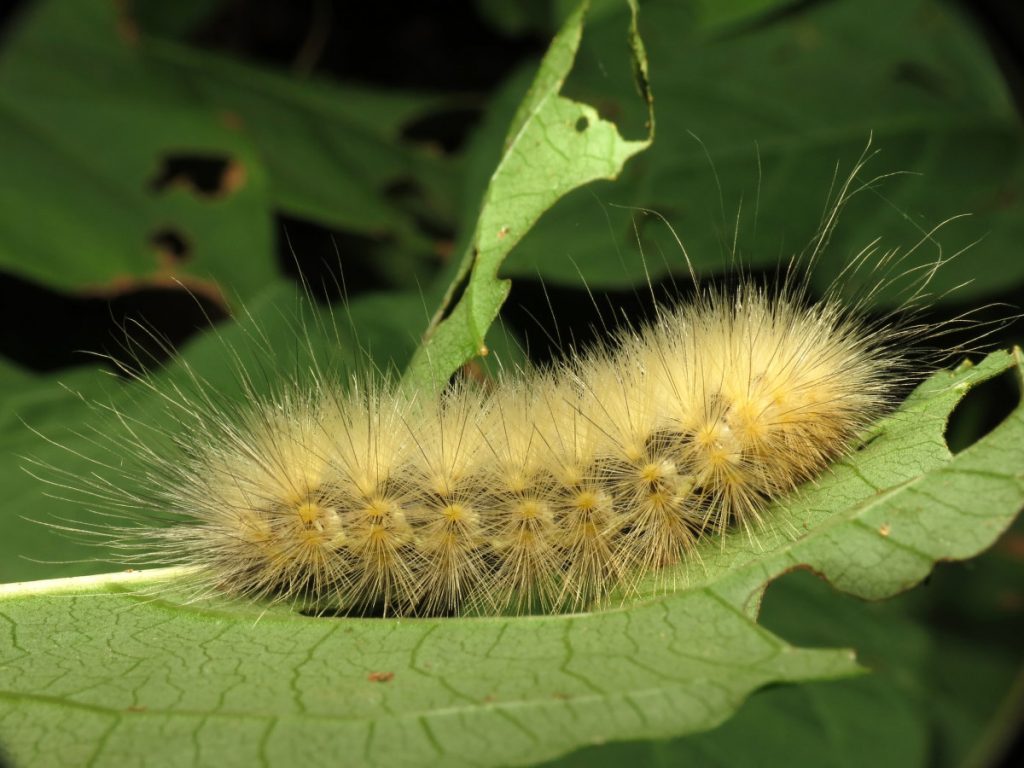Caterpillars roam around in the open as the summers begin and are seen eating food plants during the fall.
These insects can cause mild to moderate stings despite most being harmless.
The stinging hairs or spines seen on most caterpillars are hollow, filled with poison from the base of their hairs.
Interesting right? Want to know more? In a caterpillar’s life, there are 4 stages, and their life cycle is called “Complete metamorphosis.”
How to Identify Caterpillars?
The caterpillars are very easy to identify. They all have a different color, hairy covering, and random stripes all around their body.
They also have spiky bristles, which act as their defense mechanism.
Some of the caterpillars have poisonous stings, which can cause allergic reactions and skin irritation.
Different Types of Furry Caterpillars with Identification Chart and Pictures
Furry caterpillars may come across as cute and fluffy, but these furry creatures have stinging spines.
These furry creatures have various types that come in all kinds of shapes and sizes.
Most of them are covered in dense hair, giving them a furry appearance, and most come across as black and brown woolly tubes.
1. Banded Woolly Bear Caterpillar
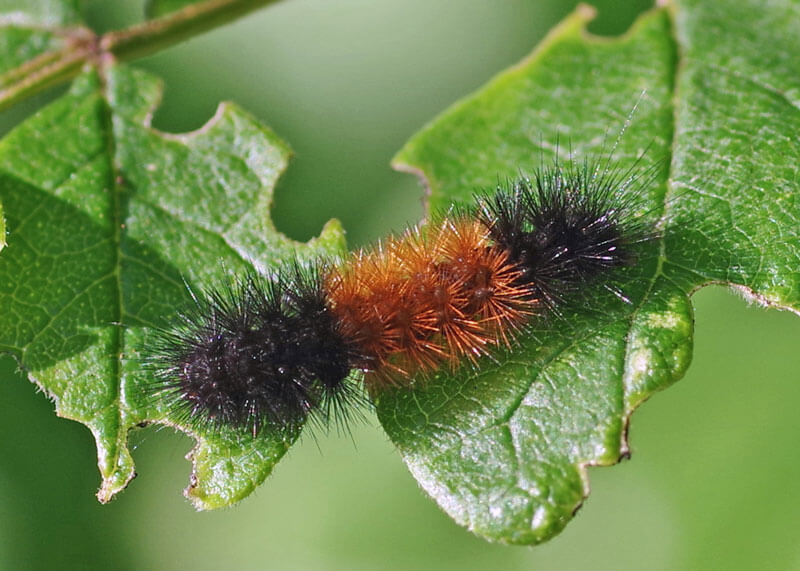
The Banded Woolly Bear Caterpillar, known as Pyrrharctia isabella, is one of the most common furry caterpillars.
It is effortless to identify them because of the dark orange and black pattern on their skin.
The body of Banded Woolly Bear Caterpillar is made up of 13 segments.
Their body is made of bristles that are pointed enough to penetrate your skin.
Do you want to know something interesting? They say these caterpillars can predict the severity of winter with the orange band in the middle of the body.
The Banded Woolly Bear Caterpillar can roll into the shape of a ball when threatened. They can grow up to a maximum size of 2″ before turning into a moth.
2. Salt Marsh Caterpillar
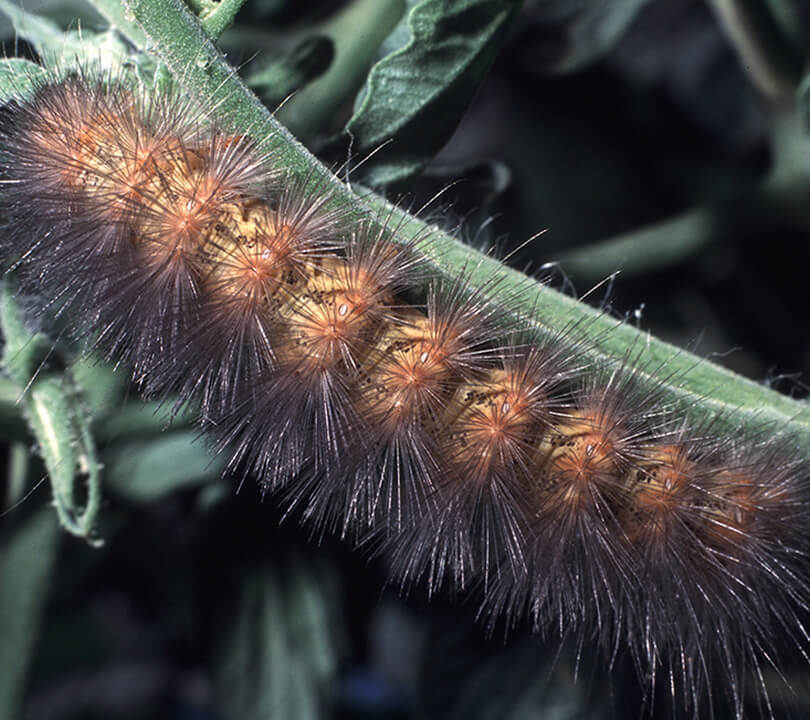
The Salt Marsh Caterpillar, also known as Estigmene acres, is another prevalent type of furry caterpillar.
These caterpillars are generally fed on tomatoes, cotton, cabbage plants, etc.
They can vary in color, right from pale yellow to dark brown and black.
The black covering on their body looks harsh but soft bristles.
You can quickly identify these caterpillars because of their black spots along the side of their body.
The Salt Marsh Caterpillar can grow to a maximum size of 2″ in length.
They mostly feed on all the different leaves and quickly grow and spin into an orange cocoon.
As adults, the moth looks very beautiful with their pale orange and white colored wings.
3. Sycamore Tussock Caterpillar
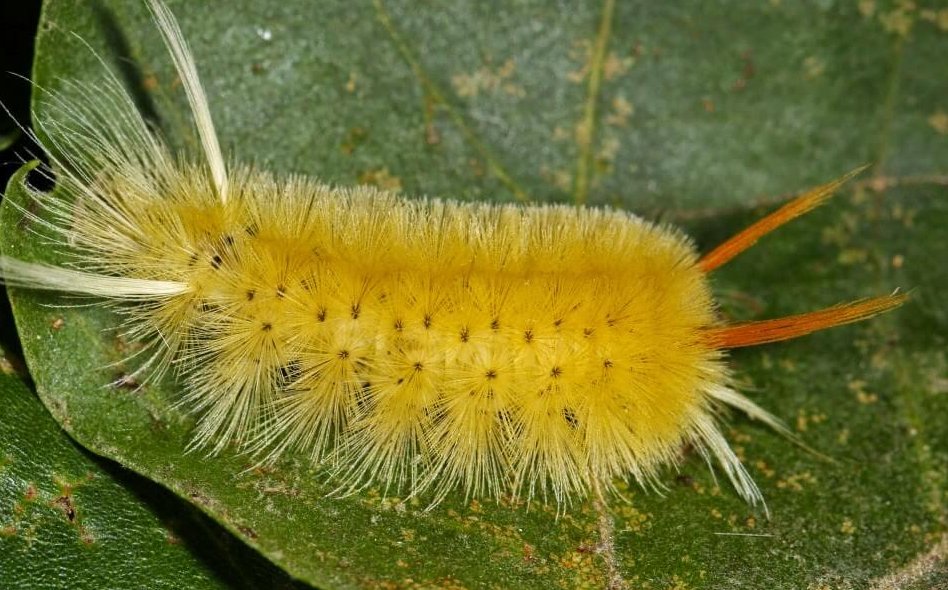
Sycamore Tussock Caterpillar, also known as Halysidota harrisii, belongs to the Erebidae family of insects. They generally feed on the sycamore trees.
These caterpillars’ are quite unusual as they have 2 white and yellow colored hair pencils at the end of their body.
Fine bristle hairs are also available along the larvae’s side part.
The bristles are generally very irritating and may also cause hives.
You can quickly identify them by their pencil hair at the rear and back of their body.
The Sycamore Tussock Caterpillar can grow to a maximum size of 1.1″.
4. Hickory Tussock Caterpillar
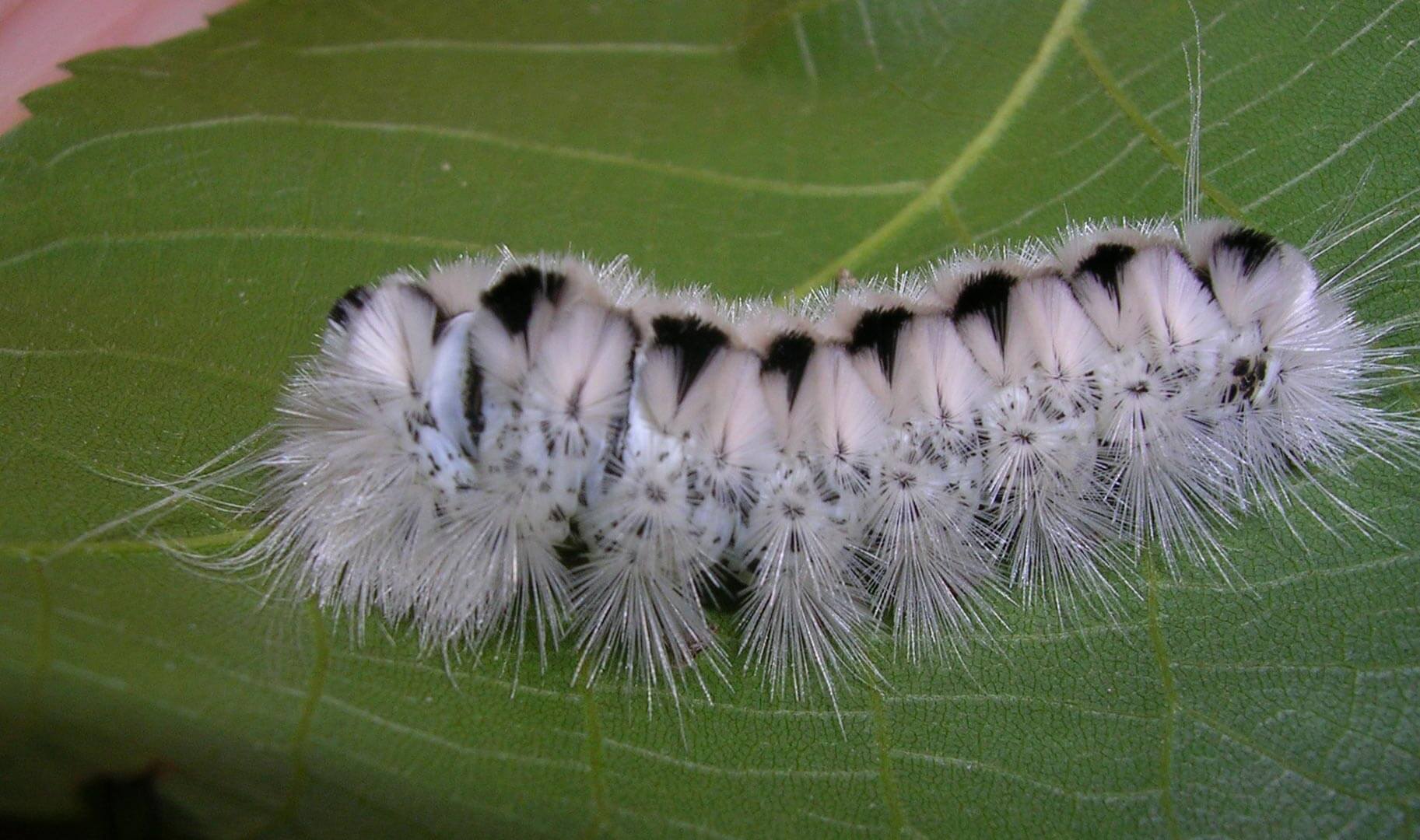
The Hickory Tussock Caterpillar, also known as Lophocampa caryae, is a hairy caterpillar.
They have black and white-colored stripes on their body, which is why they are classified in the Lophocampa genus family.
The Hickory Tussock Caterpillar is covered in the tufts.
Like the Sycamore Tussock Caterpillar, it has similar black hair pencils at each end.
The black and white stripes on their body look so harmless, but they are very irritating.
The hooked ends created great trouble and pain when they lodged in the skin.
Their black tufts of bristles generally identify them.
The Sycamore Tussock Caterpillar can grow up to a maximum size of 1.7″.
5. American Dagger Moth Caterpillar

Despite its dangerous name, the American Dagger Moth Caterpillar, also known as Acronicta Americana, is a harmless caterpillar.
They have very long bodies covered by pale, yellow-colored hairs, making them look very soft.
You can easily recognize the American Dagger Moth Caterpillar by its shiny black head.
There are two hair pencils available on the rear end.
There are 5 black colored hair pencils, two near the head and body and one at the end.
The American Dagger Moth Caterpillar can grow to a maximum size of 2.5″.
5. Io Caterpillar
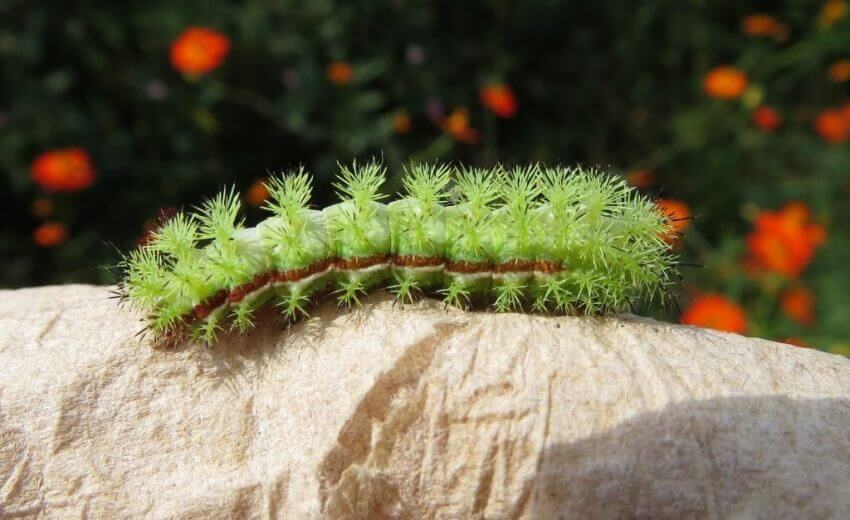
The Io Caterpillar, also known as Automeris io, is very unusual-looking and is generally found in Texas, Colorado, and Canada.
One of the most unique things about these caterpillars is their body is covered with green, black, red, and white tufts all over their body.
These creatures have poisonous spikes that cause an allergic reaction or irritation, so keeping one’s distance from them is suggested.
Its bright green color can quickly identify the Io Caterpillar. They can grow up to a maximum size of 2.3″.
Be careful while handling these caterpillars as they are very poisonous, and their venomous spines feel like a bee sting.
6. Milkweed Tiger Caterpillar
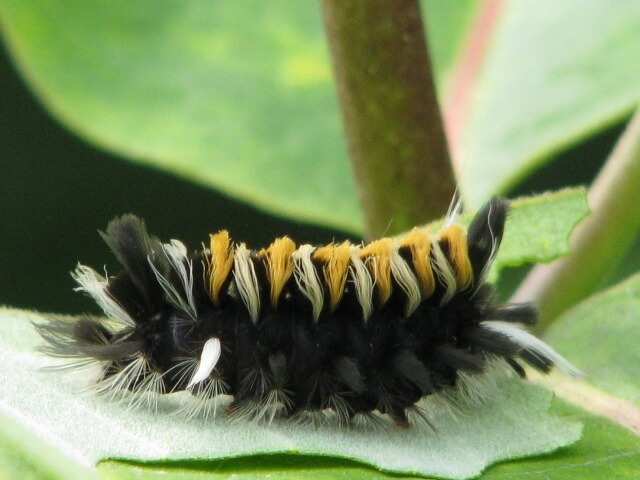
The Milkweed Tiger Caterpillar, also known as Euchaetes eagle, is a small species of furry caterpillar found in Texas and southern areas of Canada.
One can easily identify these creatures with their black, white, and hairy orange tufts. The Milkweed Tiger Caterpillar can grow to a maximum size of 1.3″.
7. European Gypsy Caterpillar
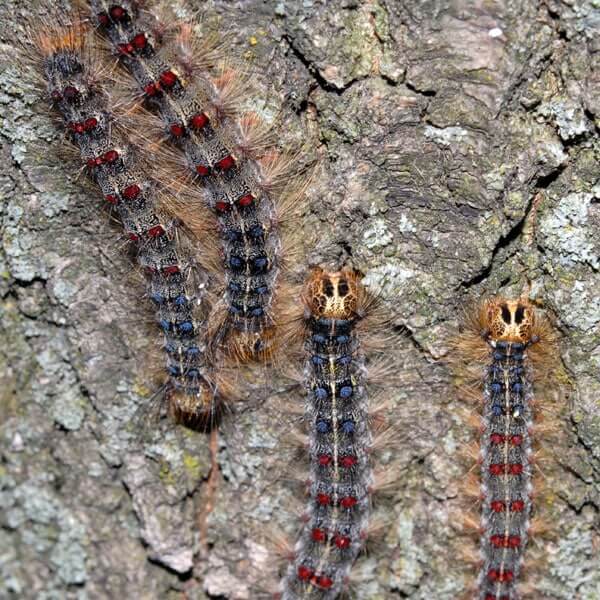
The European Gypsy Caterpillar, also known as Lymantria dispar, is a rare species of caterpillar generally found in Europe, Asia, and North America.
The European Gypsy Caterpillar has whisker-like setae sticking out in all directions.
Despite their harmless appearance, they are very destructive types of caterpillars.
They can quickly destroy large wood Aries by eating out all their leaves. It is recommended not to come in direct contact with them. Otherwise, it will result in contact allergies.
The European Gypsy Caterpillar can be easily identified by the 12 red and 10 blue colored dots on their back. They can grow to a maximum size of 2″.
8. White-Marked Tussock Moth Caterpillar
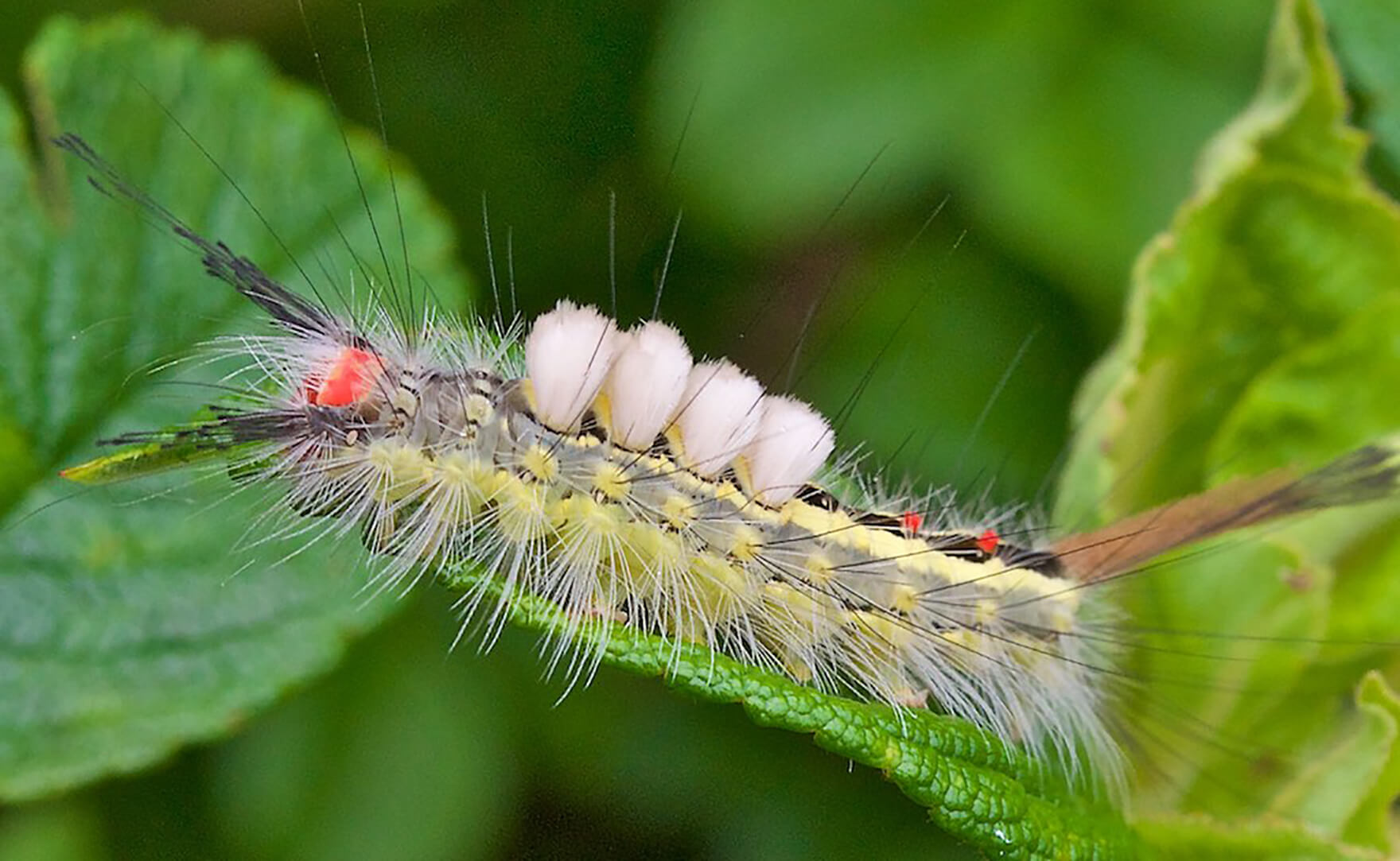
The White-Marked Tussock Moth Caterpillar, also known as Orgyia leucostigma, is a unique-looking caterpillar.
Every part of the caterpillar has a different color. The head of the caterpillar is bright red, and the back is yellow. There are
Four white-colored tufts are available on the back of the head, and brown-colored tails are at the end.
Its unique look can quickly identify the White-Marked Tussock Moth Caterpillar.
You must be careful while handling spiky caterpillars, as they can cause much irritation. They can grow up to a maximum size of 1.3″.
9. Southern Flannel Caterpillar
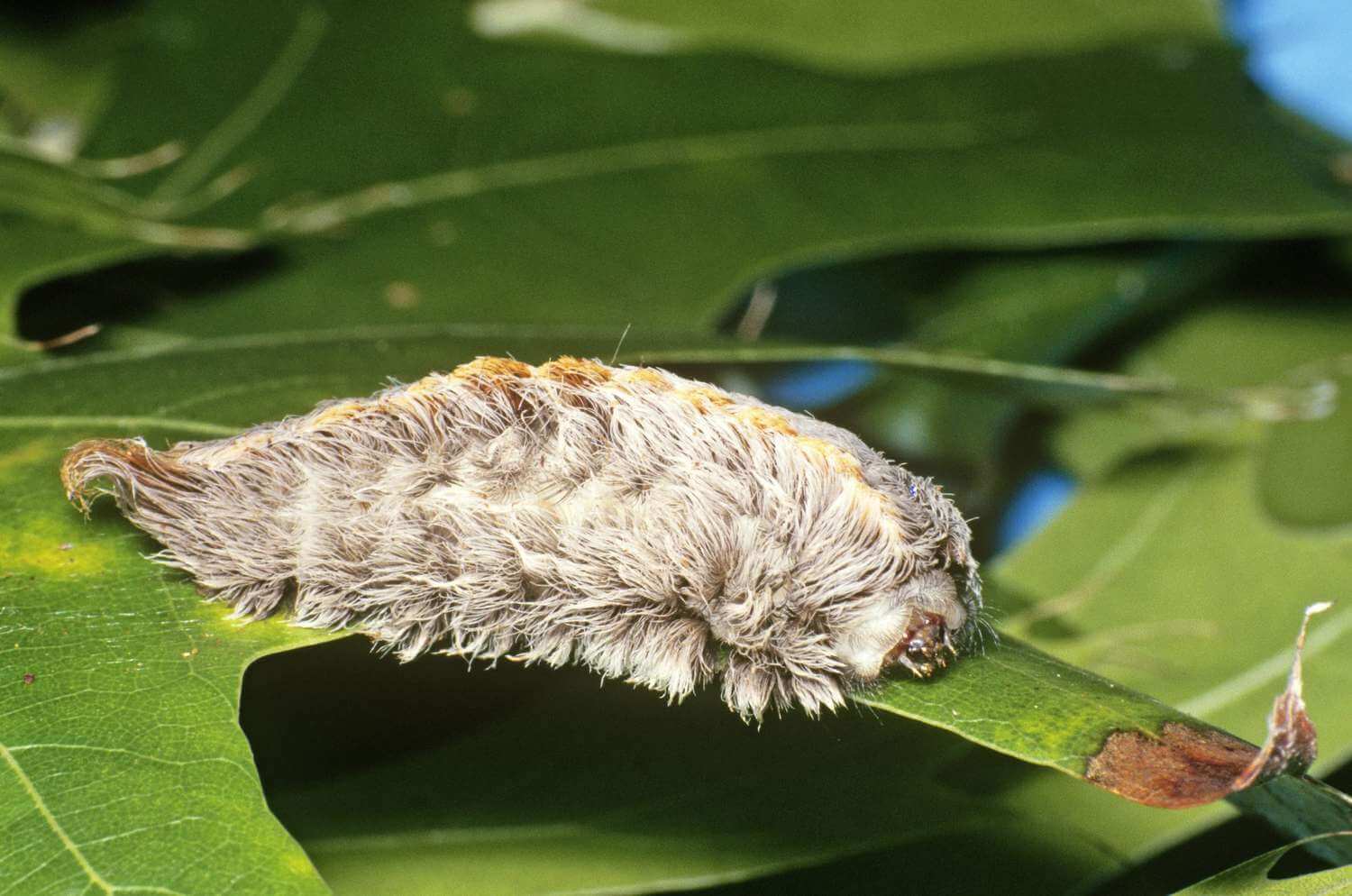
The Southern Flannel Caterpillar, also known as Megalopyge opercularis, is a tiny-looking caterpillar.
The larvae of the caterpillar are all covered with orange-colored hairs. There is also some lemon-yellow colored hair at the tail end.
Even the caterpillar looks so harmless, but it can cause painful irritation to your skin.
Its orange-colored look can quickly identify the Southern Flannel Caterpillar. They can grow up to a maximum size of 3″.
10. Western Tent Caterpillar
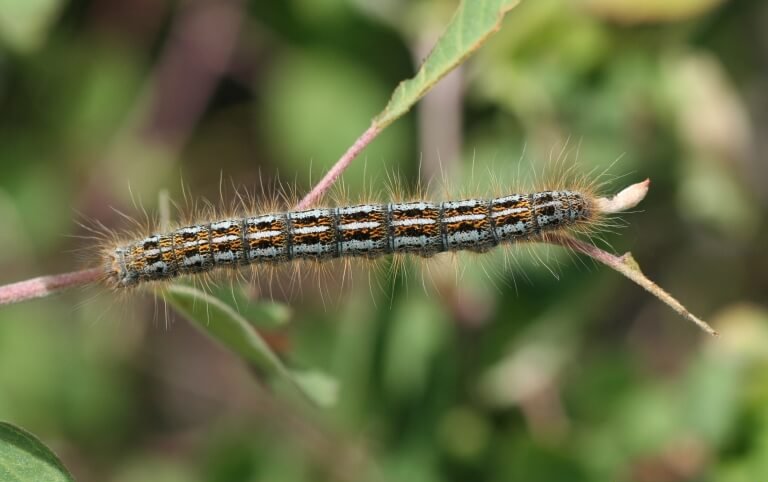
The Western Tent Caterpillar is another black species of furry caterpillar, also known as Malacosoma californicum, and is from the Lasiocampidae family.
They have a long black and orange body. Some of the other varieties of Western Tent Caterpillar are grey and white.
They live together in a large population and constitute a tent-like structure.
The Western Tent Caterpillar can be easily identified by its orange stripes. They can grow up to a maximum size of 2.5″.
11. Eastern Tent Caterpillar
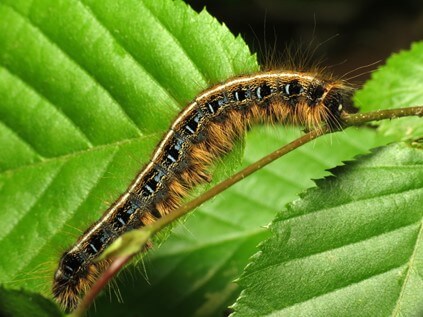
The Eastern Tent Caterpillar, also known as Malacosoma Americanum, is another type of furry caterpillar with a distinct white stripe on the back of its body.
There is also a blue marking on their body, which is noticeable by looking closely.
There are also some fine hairs of silvery-white color present on their body.
The Eastern Tent Caterpillar can be easily identified by the white stripes on its black body.
These caterpillars love to build their tents on different trees. They can grow to a maximum size of 2.3″.
12. Forest Tent Caterpillars
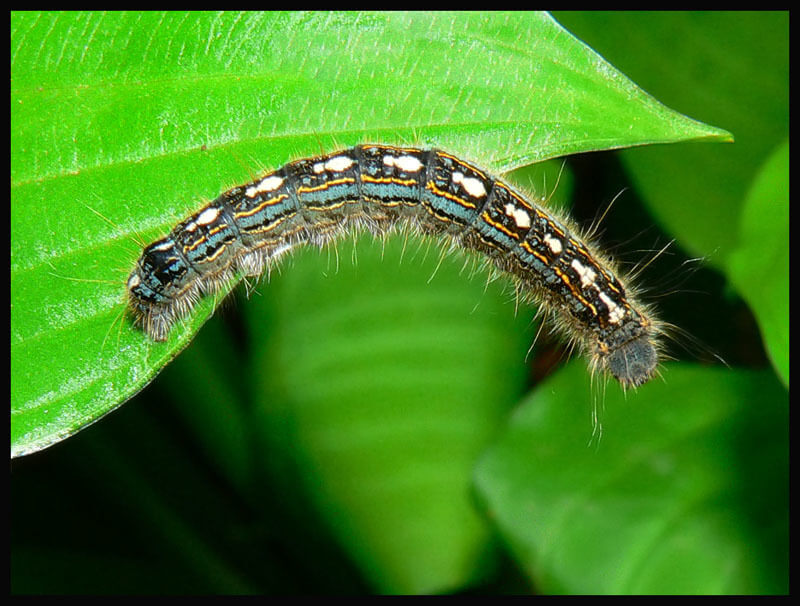
The Forest Tent Caterpillars, also known as Malacosoma Disstria have white marking on its back with blue and yellow stripes on each side.
If you have sensitive skin, then it is recommended that you do not touch it as it causes itchy red patches or skin irritation.
One can easily identify these caterpillars with yellow strips and grow to a maximum size of 2.3″.
13. Fall Webworms
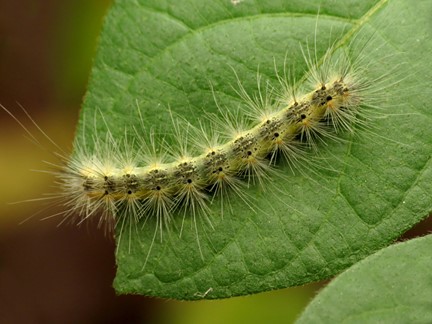
The Fall Webworm, or Hyphantria Cunea, is a small yellow hairy caterpillar with long spikes.
One of the most common colors people have often seen in this type of caterpillar is pale yellow with black dots.
They are seen nestled on various kinds of leaves like walnuts, cherries, crab apples, etc.
The Fall Webworms can be easily identified by their long tufts of setae coming out of their body. They are tiny caterpillars and can grow to a maximum size of 1″.
14. The Drinker
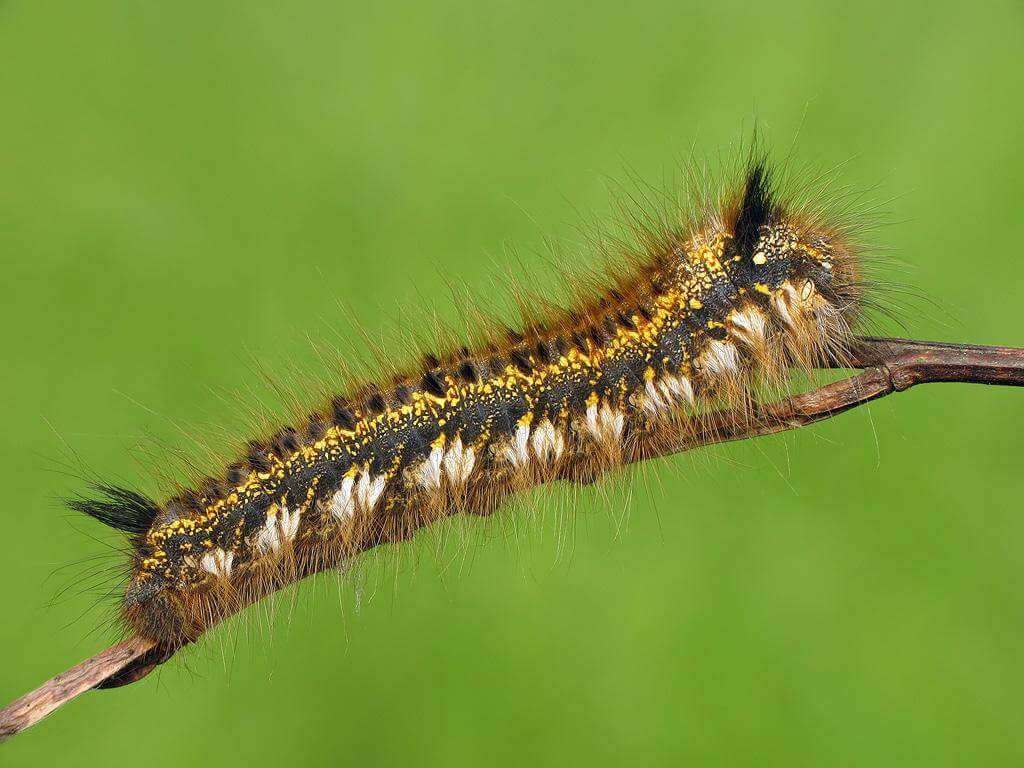
Also known as Euthrix Patatoria, the Drinker is one of the most common caterpillars known to drown their heads in water.
These moths are beautiful and glow at night. The Drinker can be easily identified by their brown and white fur in the tufts along all the sides.
They are generally found in Southeastern England and some parts of Europe.
They can grow up to a maximum size of 6 cm. The Drinker generally feeds on various kinds of grasses and reeds.
15. Saddleback Caterpillar
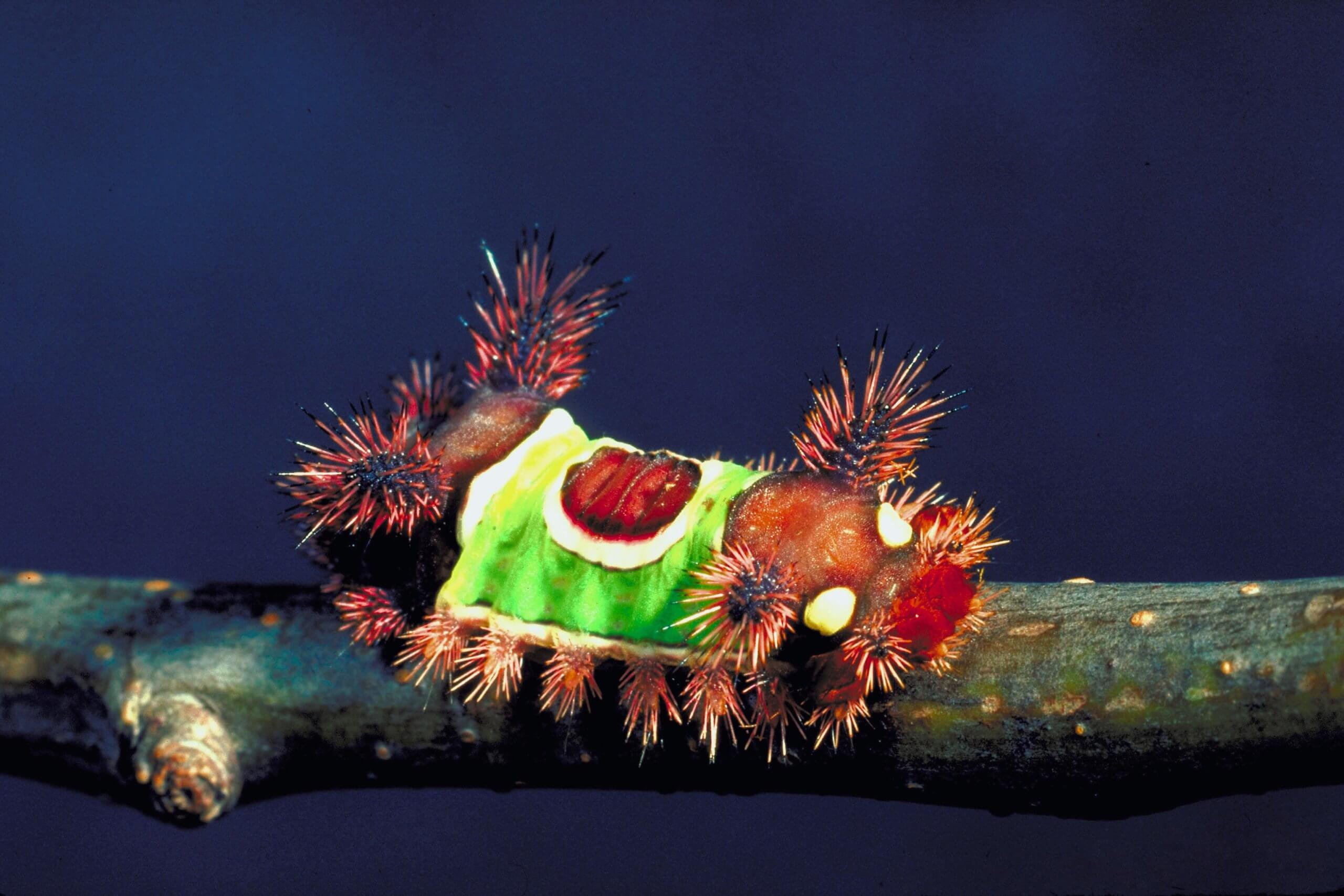
The Saddleback Caterpillar is one of the dangerous-looking caterpillars, also known as Acharya stimuli.
These caterpillars have green saddle-like markings on their back, which gives them a fantastic look.
They have two menacing eye-like structures on their head, and at the end of their body, they have long, spiky brown horns that look dangerous.
They come from the poisonous species of caterpillars. Direct contact with the hairs on the human body can also cause nausea.
The Saddleback Caterpillar can be easily identified by their lime green patch, which is available on their bodies.
They are more spiky than hairy and can grow to a maximum size of 1″.
16. Yellow Wooly Bear
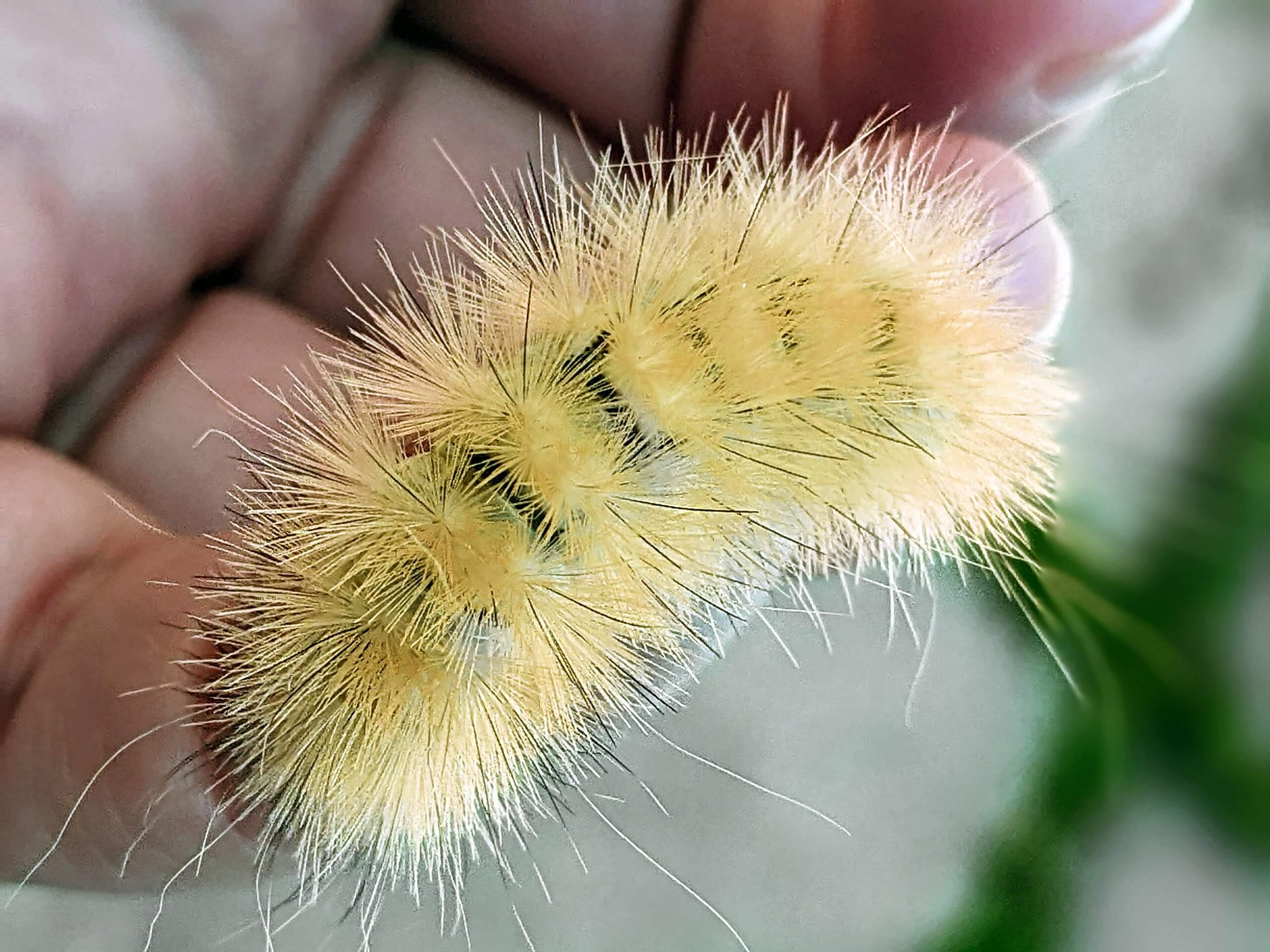
The Yellow Wooly Bear, also known as Spilosoma virginica, is a widespread type of caterpillar and is found mostly in North America.
They mostly feed on all kinds of plants and weeds. Apart from their name, “Yellow Wooly Bear,” they can vary in different colors.
The Yellow Wooly Bear can be easily identified by its short bristles, which are very similar to those of banded wooly bears. They can grow up to a maximum size of 5 cm.
These insects are very easy to raise to an adult. The Yellow Wooly Bear moth is gorgeous as it has white wings with tiny black spots on them.
17. Buck Moth Caterpillar
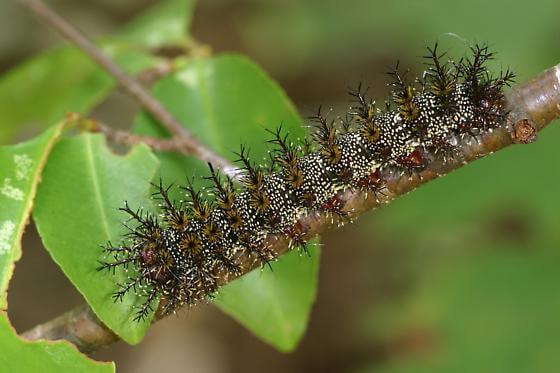
The Buck Moth Caterpillar is also known as Genus Hemileuca.
These caterpillars are generally found in groups and mostly feed on trunks of the trees.
These are very slow-moving caterpillars with a robust appearance.
They can be easily identified by their short-medium bristles, which could cause skin irritation.
The Buck Moth Caterpillar is generally found in the USA and some parts of Central America. They can grow to a maximum size of 6 cm.
18. Giant Leopard Moth
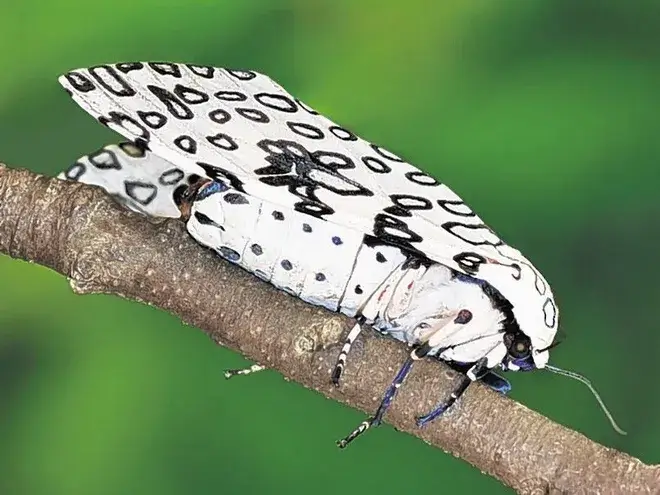
The Giant Leopard Moth, also known as Hypercompe scribonia, is known for its unique ability to roll into a ball and protrude its sharp spines from its body when disturbed.
These creatures can be identified by their thick black setae and a pair of red bands between each body segment. They can grow up to a maximum size of 5 cm. These caterpillars are very hard to raise as adults.
19. Fall Webworm
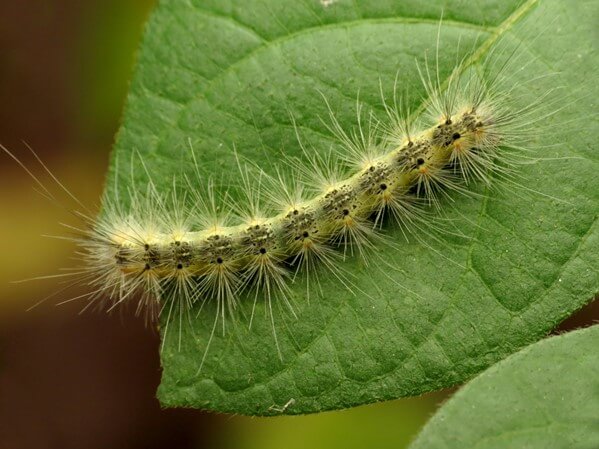
The Fall Webworm, or Hyphantria cunea, is similar to the eastern tent caterpillars.
They love to make tents at the tree crotches. Their tents are transparent, which allows you to see inside them.’
You will see caterpillars eating leaves and forming larvae. These are mostly found in the USA and Southern Canada.
The Fall Webworm can be easily identified by its pair of warts located at the back of its body.
They can grow up to a maximum size of 2.5 cm.
Conclusion
The article perfectly provides the overview with emphasizing the unique characteristics by acting as the fuzzy caterpillar identification chart.
With detailed descriptions of each species, from the Banded Woolly Bear to the Fall Webworm, the content is informative and engaging, particularly for those interested in entomology or nature observation.
Over to that the article successfully integrates essential information about caterpillar life cycles, defense mechanisms, and dietary preferences, enhancing reader understanding of these fascinating creatures.
Additionally, it addresses common questions and misconceptions, such as the potential for caterpillar stings and the non-poisonous nature of moths.
Overall, this article serves as an educational resource for anyone curious about the diverse and intriguing world of caterpillars.
Frequently Asked Questions
Are Caterpillars Considered as Insects?
The answer is Yes. At the beginning of their larvae stage, they belong to the class of Insecta.
Before turning into beautiful butterflies, they are in the pupal stage of metamorphosis.
Do Furry Caterpillars Sting?
It mostly depends on the species of the caterpillars. Only some of the caterpillars are stinging. But it is recommended that everyone not touch them with bare hands; otherwise, it will result in skin irritation, dermatitis, etc.
How to Identify Poisonous Furry Caterpillars?
It is tough to notice which caterpillars are poisonous and which are not.
To know about this, you must use the identification chart to learn more about poisonous caterpillars.
Generally, it is found that those caterpillars that are brightly colored are poisonous.
Why Are Some Caterpillars Hairy?
Most of the caterpillars are hairy because the spiky hairs in their body act as a defense mechanism.
All the poison is contained in their hair, which, in direct contact, will result in irritation or other skin diseases.
Are the moths also poisonous?
The answer is no; moths are not poisonous, but some species can irritate the skin when they come in direct contact.
What Do Furry Caterpillars Eat?
The furry caterpillars mostly reside on tree leaves and feed on different plant leaves such as apples, oak, etc.
Is it safe to raise Furry Caterpillars as a pet? It mostly depends upon the species of the caterpillar.
The caterpillar you are choosing to raise as an adult must be non-poisonous. Some of the caterpillars are very easy to raise as an adult.

